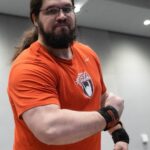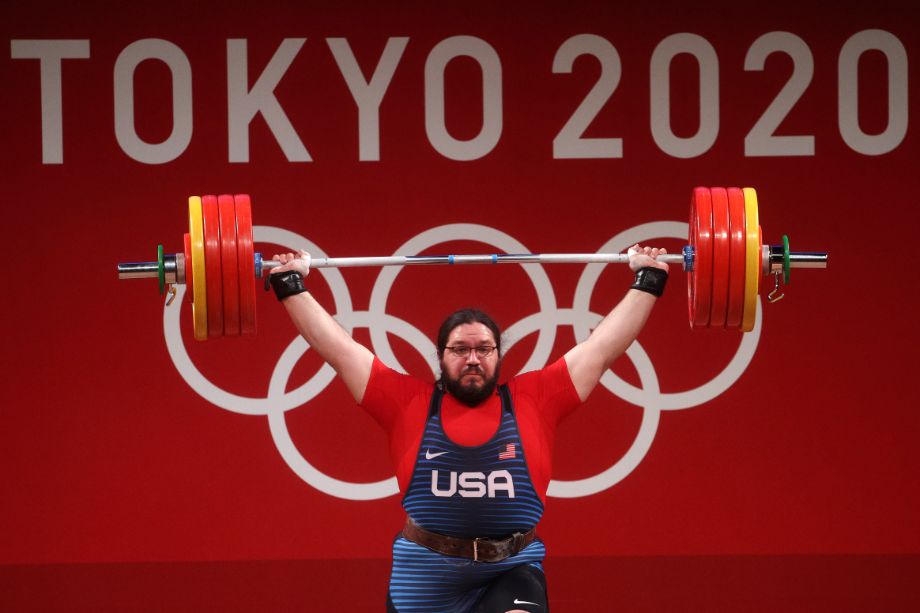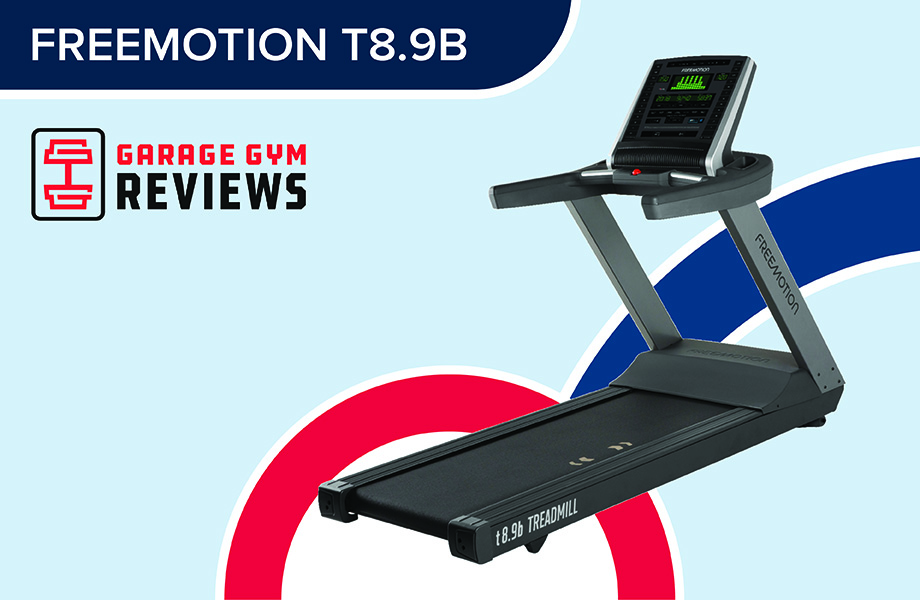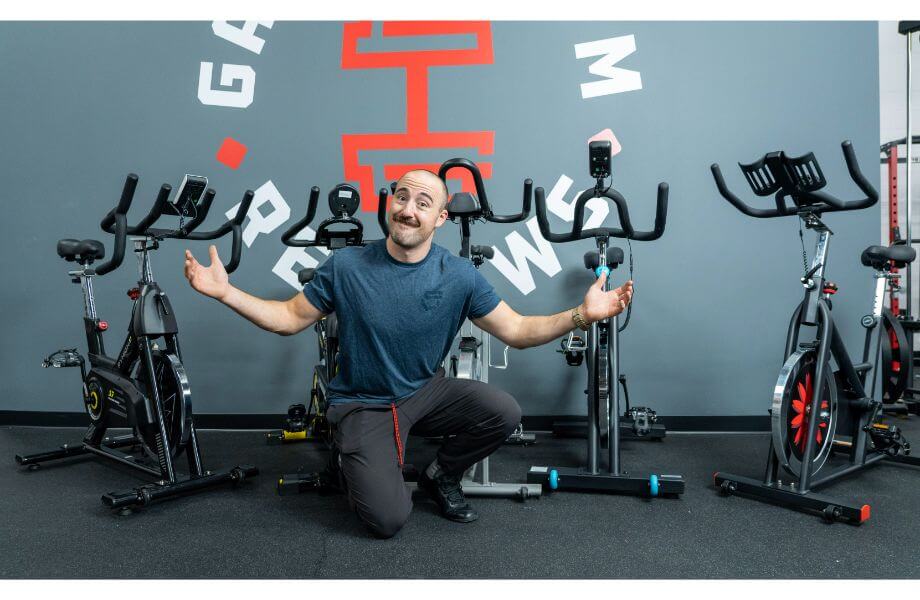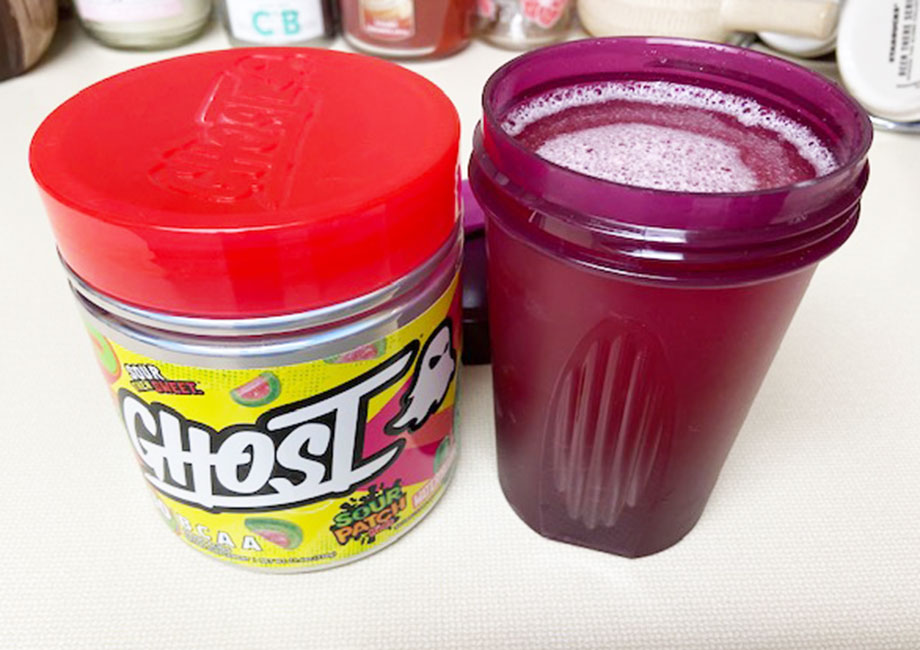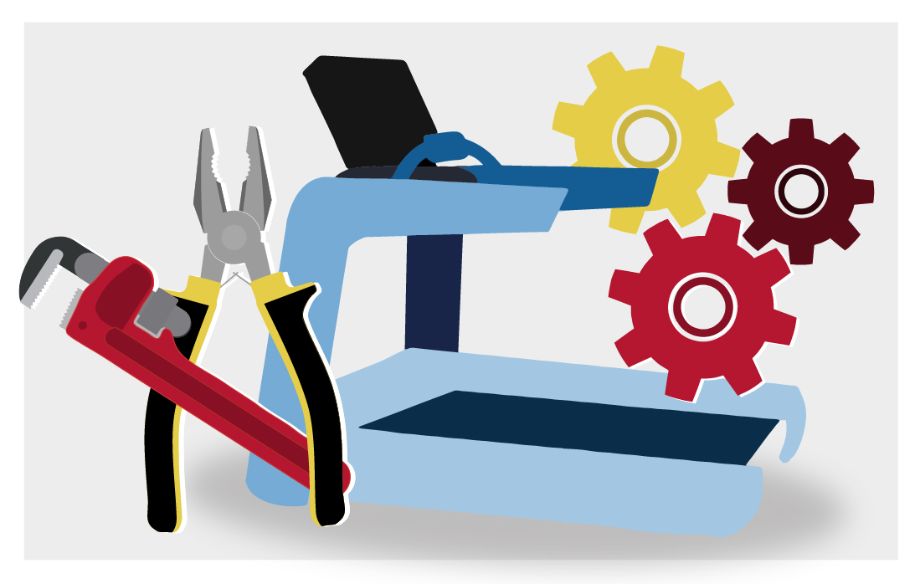Looking to get into Olympic weightlifting, but not sure where to start? Although the best Olympic barbells can look similar, there are a lot of particulars that can make it a daunting task to decide which one is best for your Olympic weightlifting home gym. Even after deciding, you have to figure out what other equipment for Olympic weightlifting you should have.
I’m here to make your job simpler. I’ve competed in the sport of Olympic-style weightlifting for over two decades now, and coached the sport for 15 of those years. I started from local competitions and worked all the way up to representing Team USA at the Tokyo Olympics. With that sort of experience, I know a thing or two about weightlifting equipment.
I’ve had all sorts of gym set-ups through the years, and I can tell you what works and what doesn’t, and what you need or what isn’t needed. I also talked to Ty Snipes, a USA Weightlifting Level 2 coach and weightlifting equipment aficionado, and in this article I’ll break down with you the essentials for an Olympic weightlifting gym, as well as the many brands of the sport.
Olympic Weightlifting Bars
The most important piece of equipment to a weightlifter is going to be an Olympic barbell. The majority of weightlifting training will be done while gripping a barbell, so you want something that feels good in your hands and can help you stay close and connected during the quick lifts of the snatch and clean and jerk.
Bars can have different shaft diameters, knurling, finishes, and tensile strengths, but for an Olympic weightlifter, we typically want a barbell that falls in line with IWF competition specifications. How much does a barbell weigh? Men will compete on a 20-kilogram barbell, while women and some youth lifters compete on a 15-kilogram barbell. There are lighter training bars available if you need to begin at a lighter weight.
Weightlifting bars are usually delineated as competition bars or training bars. The main difference is that competition barbells have more precise specifications than training bars, although some competition bars may have a more aggressive knurling as well. Competition bars are generally more expensive, too, so for most people I’d recommend a training bar for your home gym.
You also want a high tensile strength, but not too high, as then the barbell won’t have any sort of whip while performing Olympic lifts. Let’s look at some of the specs you should look for in an Olympic barbell:
- Shaft diameter: 28 millimeters for a 20-kilogram bar, 25 millimeters for a 15-kilogram bar
- Knurling: Typically a medium volcano knurling, but more importantly Olympic knurl markings, plus center knurling for a 20-kilogram bar
- Rotation system: Typically needle bearings over bushings for more spin
- Coating: Usually hard chrome or stainless steel, but this can vary
- Tensile strength: Can vary, but usually falling between 190,000 and 215,000 PSI
All the bars listed below fall in line with these specs, as well as IWF specifications.
Eleiko IWF Weightlifting Training Bar
Premium Option
Eleiko IWF Weightlifting Training Bar
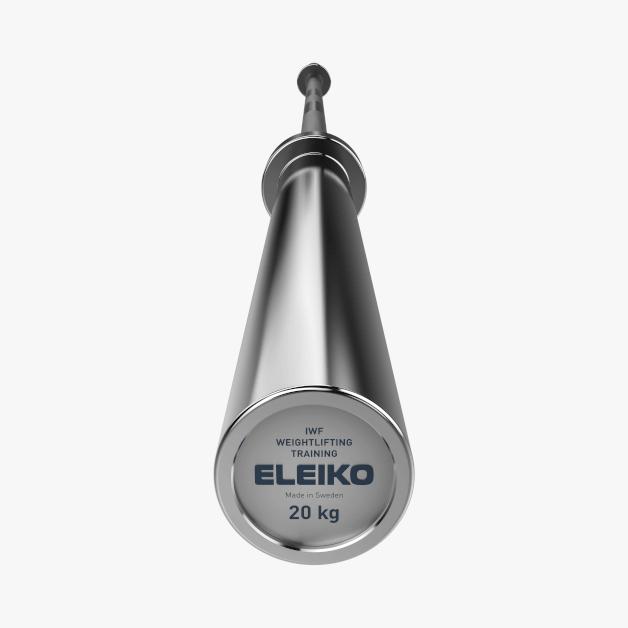
Product Highlights
Lifetime warranty for bending
International availability
IWF-certified training barbell
Pros & Cons
Pros
- IWF certification
- Smooth needle-bearing sleeves
- Balanced whip and feel
- Exceptional knurl consistency
Cons
- Premium price tag
- May be overbuilt for casual users
- Not ideal for powerlifting
Bottom Line
Eleiko’s IWF-certified training bar delivers world-class quality and smooth rotation for serious lifters. It’s a big investment but worth it for Olympic-style training, and for home gym owners wanting an exquisite barbell that’ll last for years.
This is commonly the bar that other bars are compared to. Eleiko has a history of making high-quality barbells that have been used in many competitions and weightlifting training halls. Eleiko has a reputation for creating quality products, and the IWF Weightlifting Training Bar is no different.
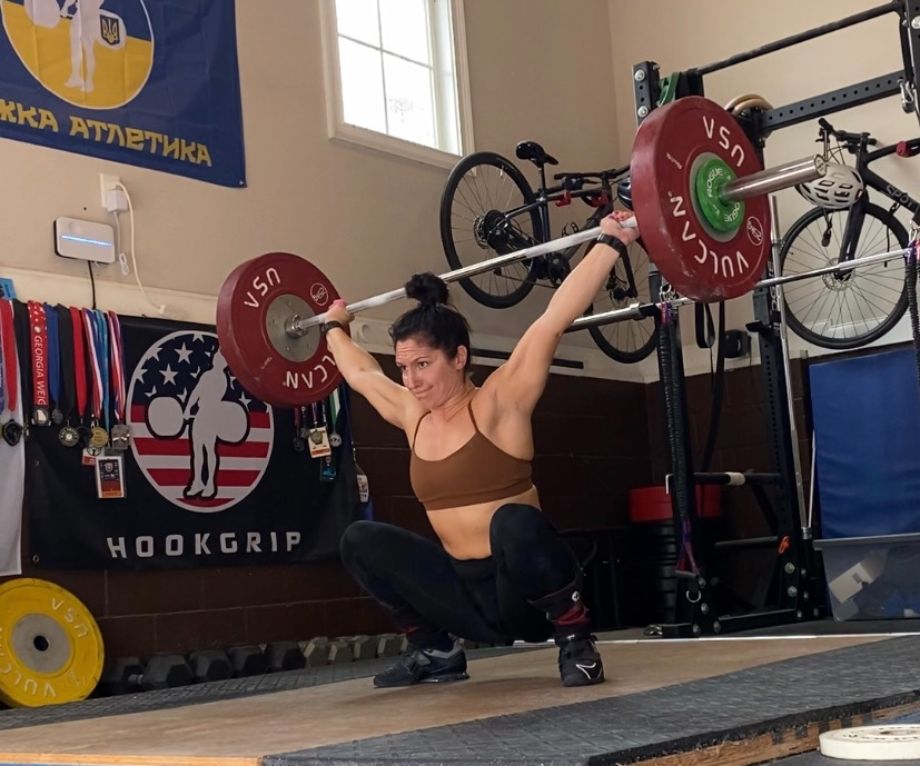
The Eleiko training bar is pretty much the same as their competition bar, albeit with a slightly less aggressive knurling (which is nice for training the lifts every day) and less precision in the weight tolerances. Their newer bars have been made for a more controlled spin, of which Ty Snipes, USA Weightlifting Level 2 coach, says, “I am a fan of the more controlled spin in the new bars, which is due to the inner race between the bearings and the shaft.”
RELATED: What Is Barbell Knurling?
Eleiko barbells all have a hard chrome finish, which most people won’t always think is the best corrosion resistant coating. However, Eleiko’s chrome finish is very resistant, as it’s very rare to see an Eleiko barbell with any rust or corrosion on the bar, even on 20-year-old bars. Although the bar’s knurling is pretty grippy, the chrome finish does give it a slick feeling if you’re not using lifting chalk. With chalk, though, the bar will feel great.
This barbell is made to IWF specs, although it doesn’t get the IWF stamp of approval, simply because it’s not certified for competition. This is also a very pricey barbell—cheaper than their competition bar, but still over $1,000 for the 15- or 20-kilogram bar.
Rogue Pyrros Bar
Our Pick
Rogue Pyrros Bar – 28MM
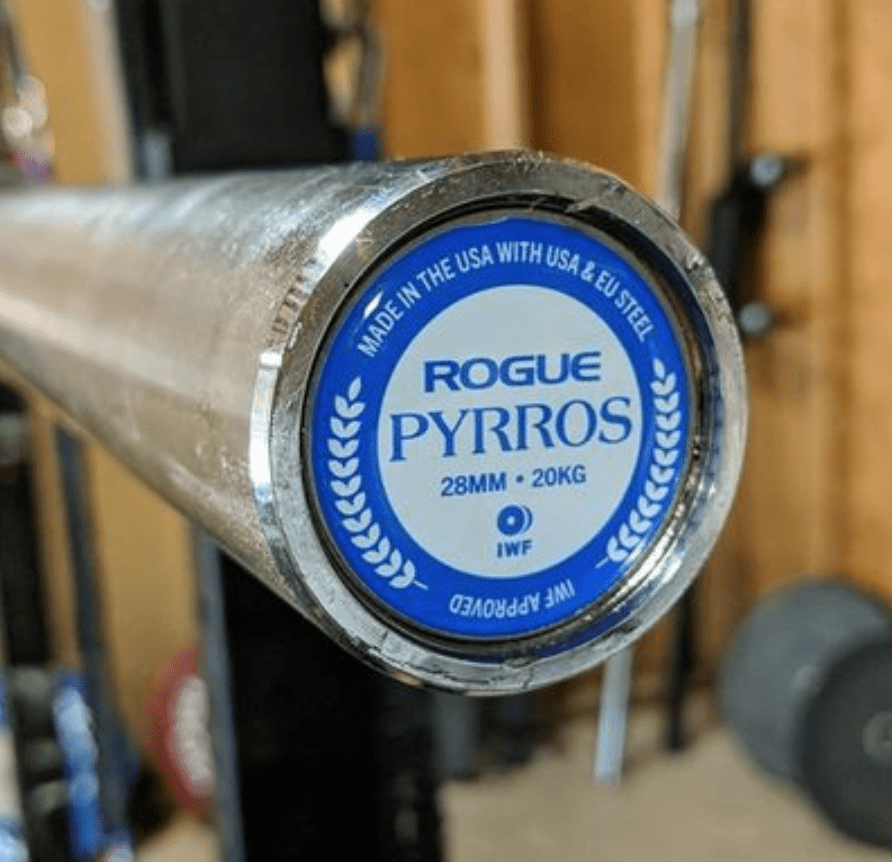
Product Highlights
- IWF-certified barbell co-developed with 3-time Olympic Gold Medalist Pyrros Dimas
- Made in the USA
- 20KG Olympic Bearing Bar (International Weightlifting Federation standards)
- Stainless steel or chrome finishes
- 28-mm diameter
- 5 needle bearings per sleeve
- Tensile Strength of 200,000 PSI
Pros & Cons
Pros
- High tensile strength
- Needle bearings
- IWF-certified
- Tight tolerances
- Made in the USA
Cons
- Expensive
- Knurling can be too aggressive for some
Bottom Line
The Pyrros Bar is the best Olympic Weightlifting Bar that Rogue offers. Its price reflects it's quality and it should be compared to the many top options available before purchased. However, Rogue has other options that are both cheaper and still receive great reviews. If you are shopping on a budget, look somewhere else. If you're a dedicated Olympic Weightlifter and want the best American made barbell, this is it.
Most competitive weightlifters have experienced the Pyrros Bar once or twice now, as Rogue is the official sponsor of USA Weightlifting. So most national-level competitions are using the Pyrros Bar for competition as well as for the training halls. Recently, the IWF certified the Pyrros Bar for international competition, so each barbell now comes with a cerakote stamp of the IWF logo on the shaft of the bar.
Developed with the insight of three-time Olympic gold medalist Pyrros Dimas (who’s now a Team USA coach), the bar was made to reflect his favorite aspects of a barbell. The bar was made with a more aggressive knurl and a smoother spin during the dynamic lifts. This has a higher tensile strength of 200,000 PSI, which will provide solid durability and bar whip.
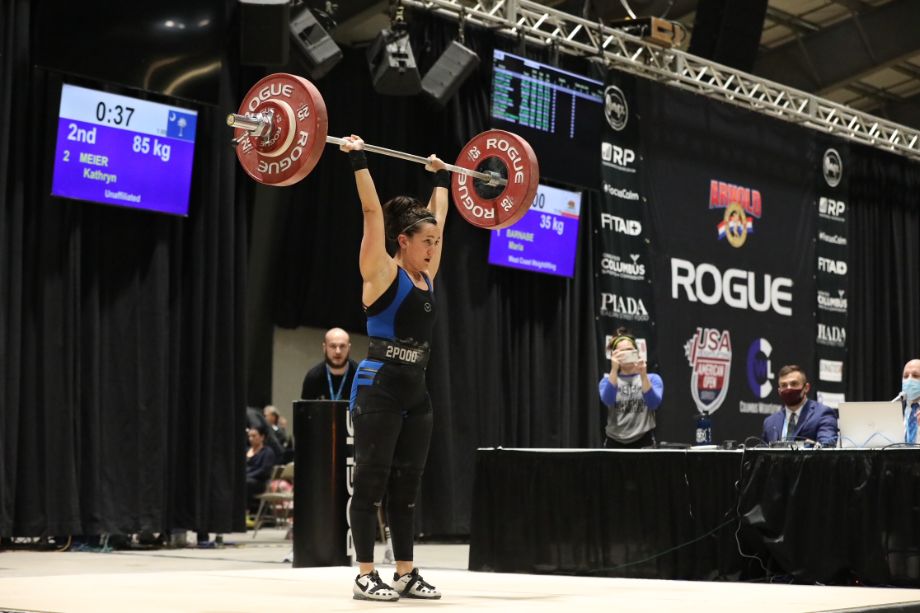
I’ve used it and Ty has used it, too, and our thoughts are pretty similar. The bar moves great and has a nice controlled spin, like Pyrros wanted. The knurling is very aggressive, more so than most Olympic weightlifting barbells, though, which may tear your hands up until you develop some calluses (they’re common in weightlifting, unfortunately). The grip and spin, however, help keep you connected to the barbell during fast, powerful Olympic lifts.
The Rogue Pyrros Bar also strikes a nice balance between value and quality, as for the level of quality of the barbell it is still fairly affordable, with the 20-kilogram barbell $615 in chrome and $720 in stainless steel.
REP Fitness Alpine Weightlifting Bar
Budget Option
REP Fitness Alpine Weightlifting Bar, 20 Kg
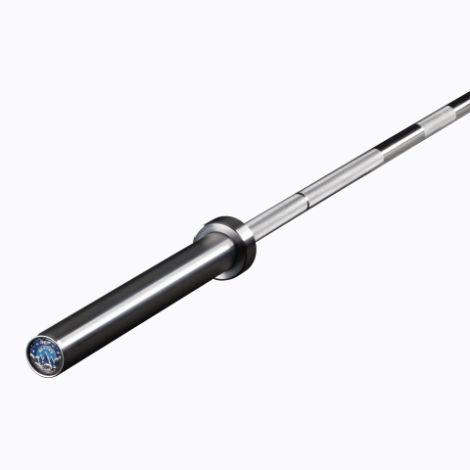
Product Highlights
- Weightlifting barbell made within IWF specifications
- 28 mm shaft diameter
- Hybrid needle bearings
- Medium volcano knurling with a passive center knurl
- Hard chrome, black chrome, or stainless steel finish
- Tensile strength of 190K PSI
Pros & Cons
Pros
- IWF specifications
- Hybrid needle bearings
- Medium knurling with a passive center knurl
- High tensile strength
- Affordable Olympic weightlifting bar
Cons
- Not an ideal barbell for powerlifting
- Thinner shaft than most multipurpose bars
Bottom Line
Designed specifically for Olympic weightlifting, the 20-kilogram Alpine Weightlifting Bar from REP Fitness is an affordable Olympic barbell that falls in line with IWF specifications. Available in a hard chrome, black chrome, or stainless steel finish, the sleeves use hybrid needle bearings to ensure a fast but controlled spin on the barbell. Because it’s made for the snatch and clean and jerk, this may not be the best choice for a powerlifting or multipurpose barbell.
REP Fitness recently updated their barbell lineup, and while we haven’t tested out the Alpine bar yet (it’s on the way), we have tested quite a few of their other bars, and the increase in quality has us excited about trying this one out.
RELATED: REP Fitness Colorado Bar Review
A dedicated Olympic weightlifting barbell can be expensive, but the Alpine can be a nice alternative to pricier options. The 20-kilogram barbell is available in hard chrome or black chrome for just $399, with a stainless steel version being $469. The 15-kilogram bar is even less, with the hard chrome version costing $349.
The bars are made with IWF specs in mind, providing proper knurl markings for weightlifting. With a medium volcano knurling, it’ll provide a solid grip without being too aggressive, and the men’s bar has center knurling to keep with IWF specifications—although the center knurling is passive.
The Alpine Weightlifting Bar also contains a hybrid needle-bearing sleeve rotation system, which uses both inner-race bearings and standard needle bearing. REP Fitness claims this blend of bearings provides a smoother and more consistent rotation. This is a quality bar at a lower price than most other weightlifting bars.
Other Barbells to Consider
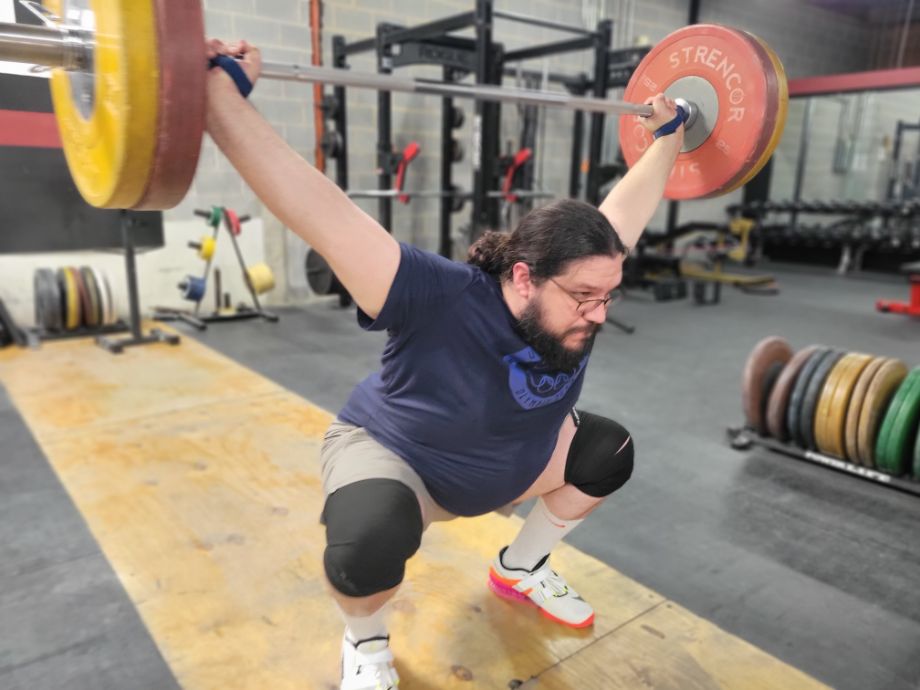
There are many barbells to consider when shopping for a weightlifting bar, and because this will be in your hands each training session, it’s smart to make sure it’s a good fit for you. Here are other options for Olympic barbells.
- American Barbell Performance Bearing Bar: This is the barbell I’ve trained on for close to a decade now. I like their medium knurling, as it isn’t too aggressive for day-in, day-out training. However, some might think the knurling isn’t grippy enough.
- Uesaka Training Bar: Uesaka claims their quality barbell is made from hagane Japanese steel, the same steel used for ancient Japanese swords. Their unique rotation system provides quality and durability, but also a slower spin than some might be used to.
- Ivanko OBSNB Stainless Steel Olympic Bar: Ivanko’s stainless steel Olympic bar has IWF specs and is high-quality, but it’s a premium barbell, costing over $1,200.
- Rogue Boneyard: This is essentially Rogue’s scratch-and-dent section, where barbells with slight blemishes are put at reduced prices. This can be a great way to find a quality barbell for very cheap.
Bumper Plates
After getting an Olympic barbell, the next step is a set of bumper plates. The best bumper plates have a moderate to high durometer, or bounce, rating (typically between 70 and 90) and are made of a durable rubber with a steel center hub.
One thing to consider is that weightlifting competitions are done with kilogram weights. If you’re wanting to compete in the sport of weightlifting, you should probably get kilogram plates, although there won’t be any difference between how the plates will perform. While you can get them in solid black, most weightlifting plates are color-coded, typically as follows:
- 5-kilogram plates are white
- 10-kilogram plates are green
- 15-kilogram plates are yellow
- 20-kilogram plates are blue
- 25-kilogram plates are red
There are training and competition bumper plates, but the main difference is the amount of weight tolerance allowed; competition bumpers are much more exact than training bumper plates.
Uesaka D-Warrior Bumper Plates
Rubber Bumper Plates
Uesaka D-Warrior Bumper Plates
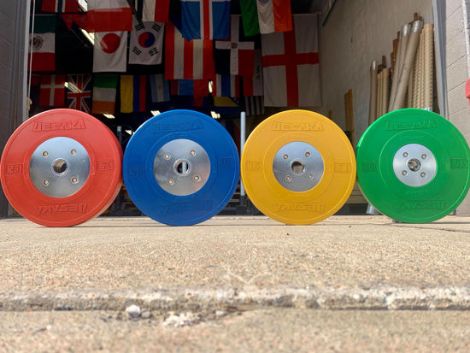
Product Highlights
- High grade rubber
- Steel center hub with hard chrome finish
- Weight tolerance of +/- 200 g
- 2-year warranty
Pros & Cons
Pros
- Durable rubber
- Steel center hub
- Bright colors
- Accurate weight tolerance
- 2-year warranty
Cons
- Pricier set of bumper plates
- Should only be dropped on proper lifting surfaces
Bottom Line
Made of the same high grade rubber as their competition bumper plates, the Uesaka D-Warrior Bumper Plates are made to be more affordable for weightlifting gyms and home gyms. While they still are a little more expensive than budget bumper plates, these plates are high-quality and provide a moderate bounce that won’t damage your floor or the weights.
One of my favorite sets of rubber bumper plates comes from weightlifting company Uesaka. The D-Warrior Bumper Plates are just like their competition and training bumpers—made with high-grade rubber and durable center hubs. The main difference? These bumper plates are significantly less expensive. The main difference is less of a weight tolerance, but for training, you won’t notice a difference.
Ty Snipes, a USA Weightlifting Level 2 coach, explains, “All Uesaka plates use the same rubber compound. The resulting softness and moderate bounce make them great plates to use in my opinion.” The preference for the amount of bounce on a bumper plate will vary person to person, but more bounce can provide more shock absorption, which can help protect your barbell and floor in the long run. However, too much bounce and your weights will fly everywhere; the Uesaka plates are just right.
Another feature of Uesaka plates is the center steel hubs. Made with high-grade tension bolts, the steel hub is secure on these rubber bumper plates. Ty mentions, “I have never seen a Uesaka plate with a loose center hub.” There are Uesaka plates at the gym I train at, and they’ve remained intact even after a few years of commercial use. These bright, color-coded plates can last in your home gym.
American Barbell Urethane Plates
Urethane Bumper Plates
American Barbell Urethane Pro Series Plates
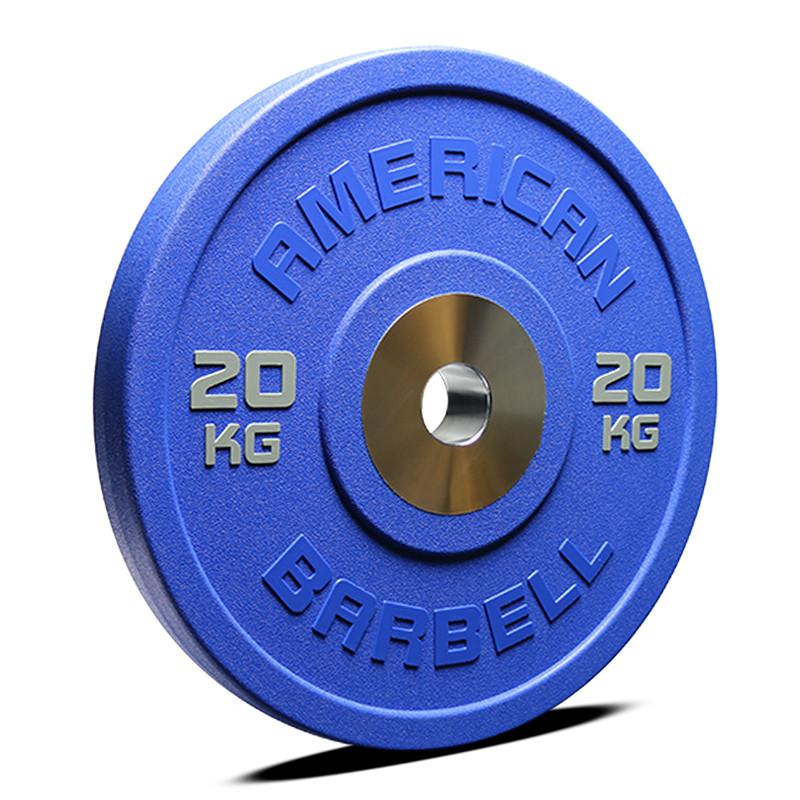
Product Highlights
- First company to manufacture urethane bumper plates
- Kilogram plates in 10-kg, 15-kg, 20-kg, and 25-kg sets
- Very durable with a hard chrome hub
- Low bounce
- Color coded to Olympic weightlifting specs
Pros & Cons
Pros
- Very durable
- Thinner width
- Hard chrome hub
- Very low bounce
Cons
- Pricier plates
- Slippery feel at first
Bottom Line
If you're looking for a pair of bumper plates that'll stand out in your gym, look no further than American Barbell's urethane bumper plates. Made to last, these durable plates have a hard chrome center hub made of a solid construction, and the plates also have a low bounce. The bright, vibrant colors are also sure to make any home gym stand out.
A newer alternative to rubber bumper plates is urethane bumper plates. Urethane is an incredibly durable material—the same material used to make skateboard wheels. Now, think of how many revolutions a skateboard wheel can turn before needing to be replaced…it’s a lot. A urethane plate has that same wild level of durability; they’ll last for quite awhile.
American Barbell was the first company to create urethane bumper plates, and I’ve used their bumper plates myself for close to a decade. They’re extremely durable and dense. I’ve never noticed so much as a scratch from these plates in the time that I’ve had them.
Each bumper has a hard chrome hub that helps with easy loading and reduced bar sleeve wear. These plates are available in pounds or in kilograms, but I’d recommend kilograms if you’re planning on competing. The urethane used provides a bright color to the weight plates.
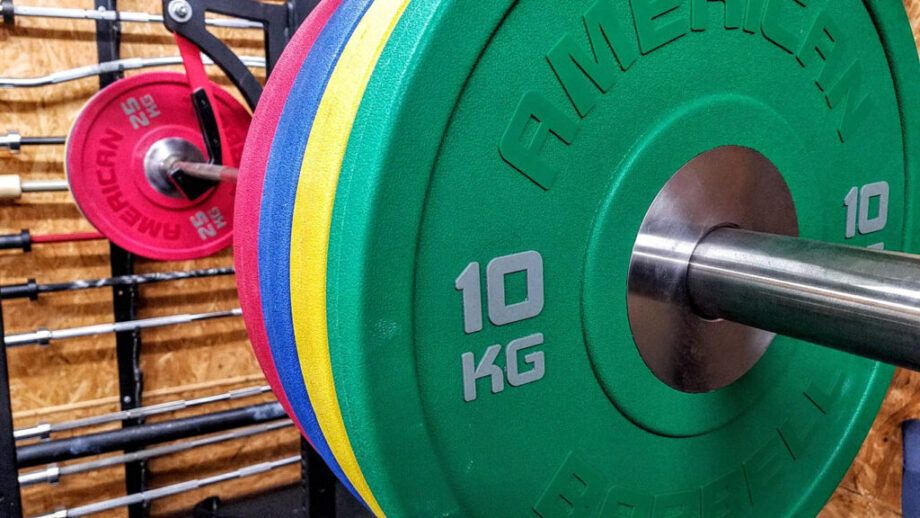
With the added quality of these bumper plates comes an added price, as getting a set of each pair of plates will cost nearly $2,000. However, their durability means you won’t have to worry about another purchase for a long time. You can see more of our thoughts in our American Barbell Urethane Bumper Plates review.
Rogue KG Change Plates
IWF Change Plates
Rogue KG Change Plates
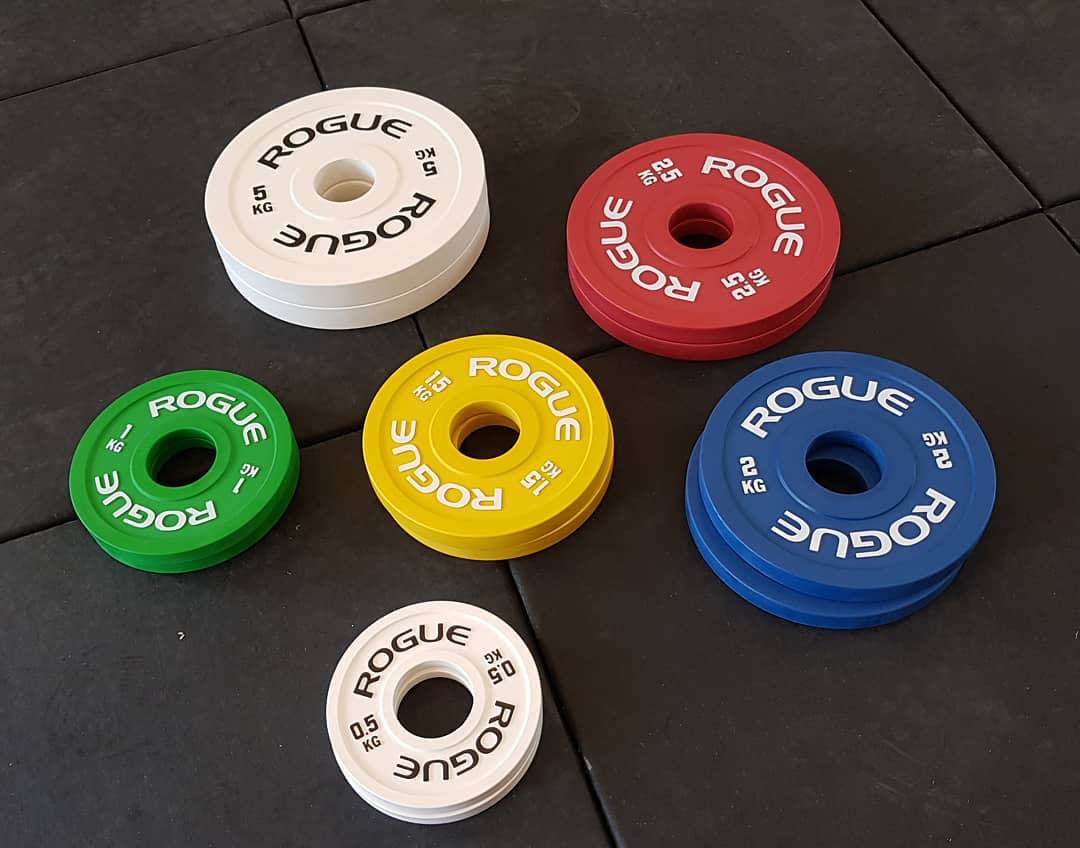
Product Highlights
- Kilogram change plates for micro-loading, personal records, and Olympic weightlifting
- Sold in pairs or as a full 25 kg set
- 50.40-mm collar opening
- Tolerance of +/- 10 g
- Rubber coating for stability and durability
- Matte finish
Pros & Cons
Pros
- Allows for micro-loading for Olympic lifting
- Color-coded
- Rubber coating for durability
Cons
- Shouldn't be used without bumper plates
- Somewhat expensive
Bottom Line
With a rubber coating for added stability and durability, Rogue Kilogram Change Plates range from 0.5 kilograms to 5 kilograms, allowing for as small of a change as 1 kilogram. These plates allow for micro-loading comparable to Olympic weightlifting competitions.
Each set of lifting plates should include a set of change plates, or fractional plates. These plates can make smaller changes in weight jumps. In competition, you can make as little of a jump as 1 kilogram; Rogue’s Kilogram Change Plates mimic the same jumps, providing fractional plates for similar jumps.
Plates range from 0.5 kilograms to 5 kilograms, and there are a total of six pairs of plates in a set, each color-coded for easy reference. You can purchase these change plates in an entire set, or as individual pairs. The whole set is $310, which is a pretty fair price—especially if you factor in the free shipping.
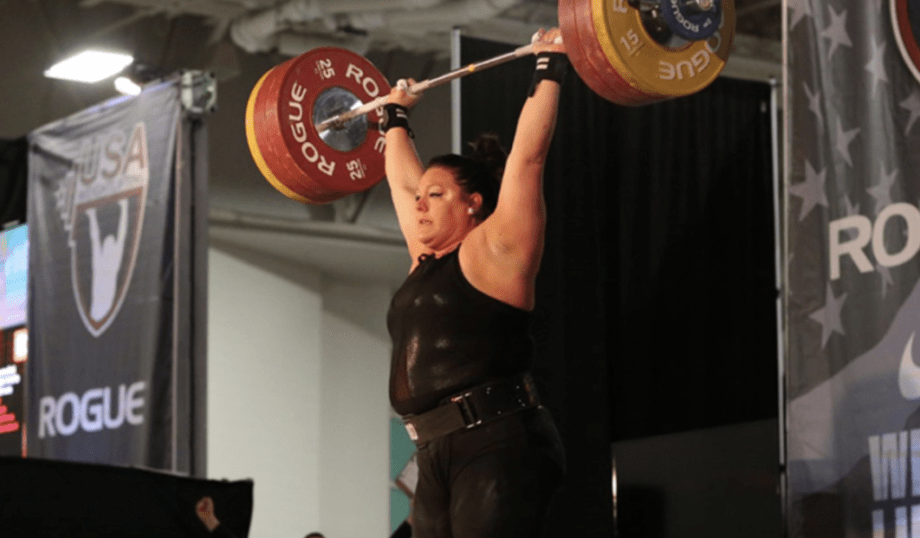
Each weight plate has a rubber coating for durability; if you accidentally drop a change plate, it has less of a chance of dinging up the floor.
It should be mentioned, however, that change plates shouldn’t ever be used on their own. You should always have a larger bumper plate on to protect the change plates. Direct impact to the floor from a change plate can cause serious damage to the plate—or the floor.
REP Fitness Black Bumper Plates
Budget Option
REP Black Bumper Plates
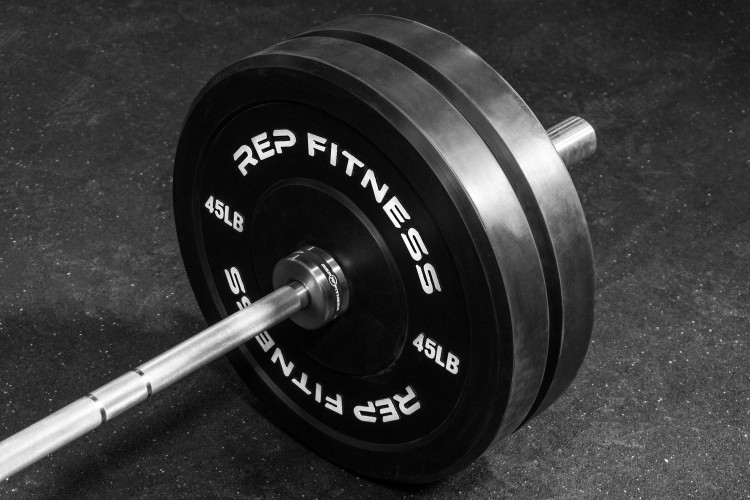
Product Highlights
- Extremely durable and attractive
- Ideal for cross-training and Olympic weightlifting
- 10-lb plates are extra thick (1″) to increase durability
- 45-lb plates are thinner than most at 2″
Pros & Cons
Pros
- Extremely durable and attractive
- Ideal for cross-training and Olympic weightlifting
- 10-lb plates are extra thick (1") to increase durability
- 45-lb plates are thinner than most at 2"
Cons
- 3% weight tolerance is pretty high
- Like many rubber bumpers, may smell a little for some
- No 55-lb option
Bottom Line
The REP Black Bumper Plates are extremely durable and feature a thick 10-lb plate meant to withstand drops.
If you’re not wanting to drop a lot of money on bumper plates, and don’t need to worry about color-coding weights, then the REP Fitness Black Bumper Plates can be a solid choice. Available in pounds or kilograms, you can get a set of 340 pounds of weight plates all for under $750.
These weight plates are made of a dense virgin rubber that provides a low bounce, which helps weights from bouncing back into you after a successful lift. For a black bumper plate, they have a pretty sharp look, as well. The plates are solid black, except for a contrasting white text of the company name and weight of the bumper.
A nice difference is that the 10-pound plates have been designed to be a little thicker than most 10-pound plates, which are notorious for bending and bowing after drops. These 10-pound plates help provide stability, and all plates are tested to withstand 12,000 drops from a height of 8 feet.
Other Plates to Consider
There are plenty of other bumper plates to consider. Here are just a couple others:
- Ivanko Calibrated Olympic Bumper Plates: Ivanko has non-calibrated and calibrated bumper plates. The calibrated plates have a far smaller weight tolerance to ensure that the weights are exact. The calibration does raise the cost of these plates, though.
- Vulcan Absolute Competition Kilogram Change Plates: These fractional plates from Vulcan are of the same quality as their competition plates, and run from half-kilogram plates to 2.5-kilogram plates. Each plate is color-coded for easy reference, and allows for as little as 1-kilogram jumps between lifts.
Lifting Platforms

I’ve lifted on a variety of platforms—rubber, plywood, concrete, asphalt—and while you can lift just about anywhere, building a solid lifting platform helps you stay safe and connected in your lifts. Building or purchasing a lifting platform will help protect your flooring from continuous weight drops, and it will give your joints a bit more support during the dynamic movements of the snatch and clean and jerk.
Tractor Supply Horse Stall Mats
DIY Option
Tractor Supply 3/4″ Rubber Stall Mats
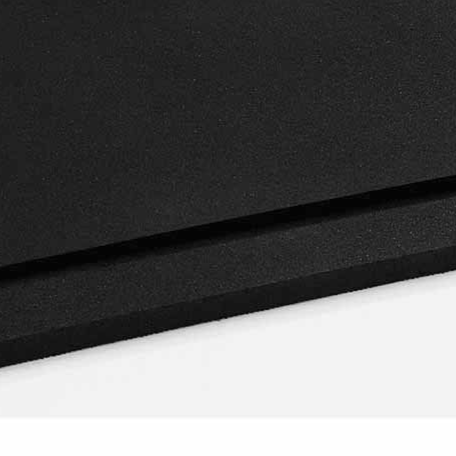
Product Highlights
- Multi-use rubber mats with a textured surface
- Shock- and sound-absorbent
- Affordable
Pros & Cons
Pros
- Great durability for any exercise
- Anti-skid surface
- Good noise reduction for dropped barbells
- Less than $60/piece (less than $2.50/square foot)
- Five-year warranty from Tractor Supply
Cons
- Heavy, weighing around 100 pounds for each piece
- Some people don’t like the rubber smell
- Surface is not smooth; these have raised bumps
- May be harder to clean than smooth surfaces
Bottom Line
These horse stall mats from Tractor Supply use recycled rubber, are 3/4" thick, 4 'x 6' in size, and weigh upwards of 100 pounds. You can find horse stall mats at other farm supply stores, and they will be similar in dimensions. The thickness makes this flooring sound-absorbent.
Although there are a lot of cool options for gym flooring for a lifting platform, one of our favorite ways is to use Tractor Supply Horse Stall Mats in making your weightlifting platform. You can lay down a layer—or two, depending on how much protection you want for your flooring—of plywood and layer horse stall mats on top, to make a pretty durable platform that will also give your knees a little give over long-term use.
If you have the stall mats on their own, the underside of the mat has rounded bumps, which will allow water to travel through, and also provide an anti-slip surface against the floor. The flat surface up top provides a solid cushioning ideal for lifting.
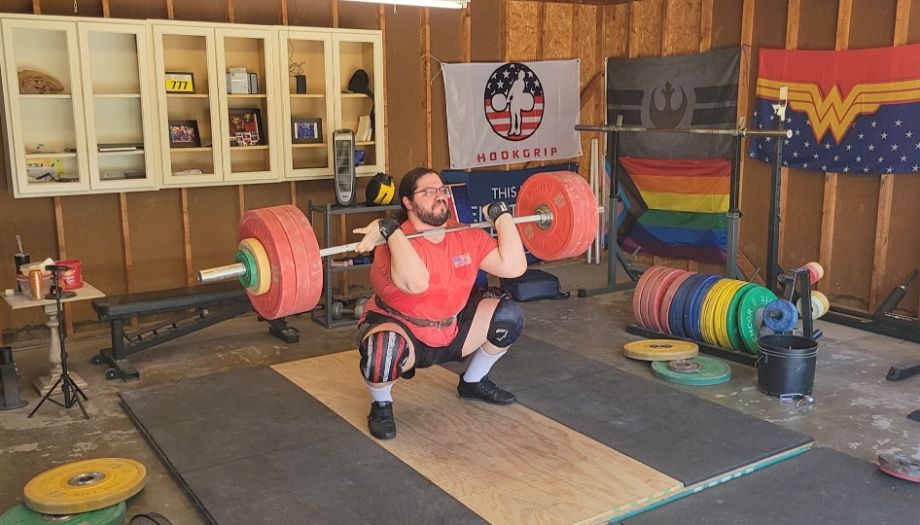
The 3/4-inch thick rubber mats can help dampen sound by absorbing the impact of a heavy barbell once it’s dropped, which is great for weightlifting…if you know anything about the sport, you’ll know weights are dropped a lot, even after successful lifts.
These mats are heavy, at nearly 100 pounds, so you’re likely going to want to leave these mats where you initially put them down. Also, cutting these mats down can be a real chore. But their inexpensive price and overall durability make them one of our favorite mats to recommend.
Looking for inspiration? Here’s our how-to on building a DIY weightlifting platform with a squat stand attached.
Eleiko Dampening Floor Tile
Premium Option
Eleiko Gym Floor Tile
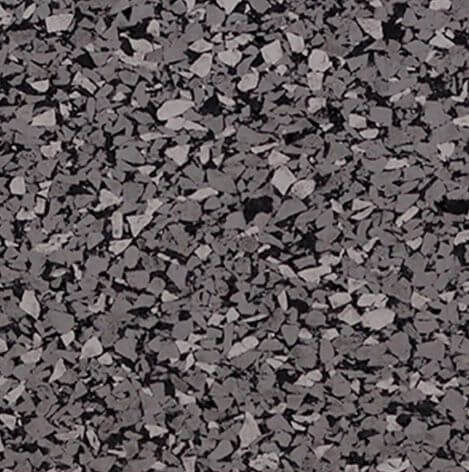
Product Highlights
- Minimizes noise, vibrations, and bounce
- Slip-resistant
- 2 color options available
- Interlocking design for easy installation
Pros & Cons
Pros
- Durable flooring option for a variety of fitness spaces
- Sturdy construction protects your investment for longevity and high performance
- Can be used in both wet and dry environments
- Reduces the impact of dumbbells or weights dropped on your floor
- Engineered with a patented high-density wear layer for durability and efficiency
- Sold individually, allows you to buy exactly what you need for your space
Cons
- Could get a little expensive depending on the size of your gym space
Bottom Line
These floor tiles not only can be used to protect your floor and your weights, but they also add extra cushion for your body as you work through your lifting session. The interlocking design makes it easy to fit your gym space with the floor tiles and also gives it a nice overall aesthetic. By being easy to maintain and simple to use, these floor tiles are a great addition to any gym space. Although these tiles are on the expensive side, the use of high-quality materials for these floor tiles will keep your gym looking great for years to come. However, if you are trying to find tiles for your gym while on a budget, it may be best to look into other options.
If you’re looking for an impressive floor tile for your lifting platform, Eleiko provides a premium option. Their dampening floor tile provides solid protection against your gym floor, as well as helping deaden noises from dropped weights. The tiles are made to be slip-resistant, noise-reducing, and provide solid grip, too.
The floor tiles come in two colors: Swedish Steel and Nordic Night. As epic and metal as those names may sound, it’s more of a choice between gray speckled with black, or black speckled with gray. Each tile is backed by a 15-year warranty, too.
Garage Gym Reviews videographer Nathan Hay has these floor tiles at his home gym and thinks they add a lot to his home gym. “They’re super high-quality tiles. I never have any worry about dropping any weights on them. They can take any amount of punishment and they look amazing in my garage,” he says.
This is definitely one of the more expensive flooring solutions, as one 2-foot-by-2-foot square tile costs $79 dollars, but they are very durable. You can also just buy a few and lay them into your lifting platform where the majority of weights will drop, and fill the rest in with solid plywood.
Other Platforms
Here another idea for a lifting platform for your future home gym:
- Rogue 8’ x 8’ Oly Platform: 8 feet by 8 feet is the typical size of a lifting platform in training, so Rogue’s Oly Platform provides that space with a solid 2-inch-by-2-inch steel frame. You can purchase the platform with rubber tiles, or fill it with your own horse stall mats or plywood.
Squat Stands
Although bolted-down power racks and rigs will work just fine, squat stands are typically the used method of squatting in an Olympic weightlifting gym. The reason for this is that you’re doing all of your lifting on a weightlifting platform, so you want a squat rack that is mobile and that can be moved on and off the platform in between uses. Squat stands come in all shapes and sizes, with different weight capacities and also different footprints.
Rogue S-1 Squat Stand 2.0
Our Pick
Rogue S-1 Squat Stand 2.0
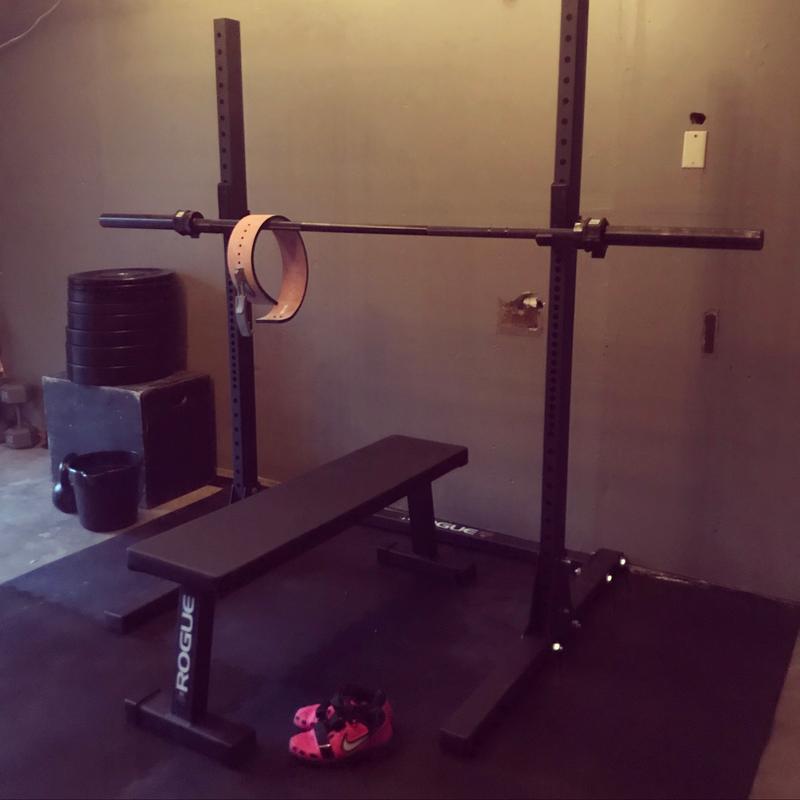
Product Highlights
- 48″ D x 48″ W x 72″ H
- 114-lb squat stand
- Weight capacity of over 1,000 lbs
- 2″ x 3″ 11-gauge steel
- Westside hole spacing
Pros & Cons
Pros
- 11-gauge steel
- High weight rating
- Heavy-duty construction
- UHMW liners on J-hooks
Cons
- No pull-up bar
- Not as sturdy as a bolted-down power rack
Bottom Line
The updated Rogue S-1 Squat Stand is a heavy-duty stand with a high weight capacity of over 1,000 pounds. Made from 11-gauge steel, this stand will last, plus the UHMW liners on the J-hooks will help protect your barbell from metal-on-metal wear.
Since USA Weightlifting is sponsored by Rogue Fitness, I’ve used their S-1 Squat Stand quite a few times at national camps and training halls. These stands are made from 2-inch-by-3-inch 11-gauge steel with 5/8-inch holes, spaced 2 inches apart, except for in the bench zone where Westside hole spacing is used. While the bench press isn’t a common exercise for Olympic weightlifters, it’s nice to have the option.
I’ve done plenty of front and back squats from these stands, with loads over 600 pounds before, and I’ve never once felt like the rack was unstable when I racked weights on it. The 2.0 redesign uses a triangle base to keep the uprights stable, no matter what the load is.

At $395, this is also one of the more affordable squat stands available, and with it being Rogue, the American-made material is high quality. However, this is also one of the bulkier squat stands, being 4 feet long and 4 feet wide. Because you typically don’t want a stand on your lifting platform during Olympic lifts, you’ll need to make sure you have that real estate available elsewhere in your garage gym.
Other Squat Stands
Here are a few other squat racks to look at for your weightlifting garage gym:
- Eleiko Classic Squat Stand: This is the style of squat stand you’ll typically see in international competitions. These compact squat stands can adjust the height and width of the posts. Bring them in enough and the knurled handles in the back can be used as dip bars.
- ZKC Mobile Squat Racks: These mobile squat racks are based on traditional Chinese weightlifting squat racks, which have concave surfaces supported by four posts. These are a rare design, but fairly compact and mobile.
- REP PR-4000 Power Rack: If you need that beefy feel of a power rack, one of our favorites at Garage Gym Reviews is the PR-4000 by Rep Fitness. With 11-gauge steel and a weight capacity of over 1,000 pounds, this power rack will hold your heaviest loads easily. Plus, it has a pull-up bar for bodyweight training, and plenty of room for power rack attachments.
Other Training Tools
Outside of a solid platform, a barbell, and weights, there are other tools and pieces of equipment available to help your Olympic lifting training and home gym space. Here are some more ideas on equipment for your weightlifting program.
Plate Racks
So, you probably have some of the nicest weights and barbells you can muster in your Olympic lifting home gym. Now, you have to figure out where all of that equipment is going to go. This brings the need for plate racks. The best plate trees and plate racks help keep plates and barbells out of the way when you’re not using them, keeping your home gym safe and spacious.
Plate racks will keep bumper plates low to the ground, which is ideal since the majority of your lifts will start from the floor. With that said, plate trees will work just as well, and both may have vertical bar storage for your Olympic barbell. You can check out our picks for the best home gym storage for more ideas on how to store your fitness equipment.
Lifting Chalk
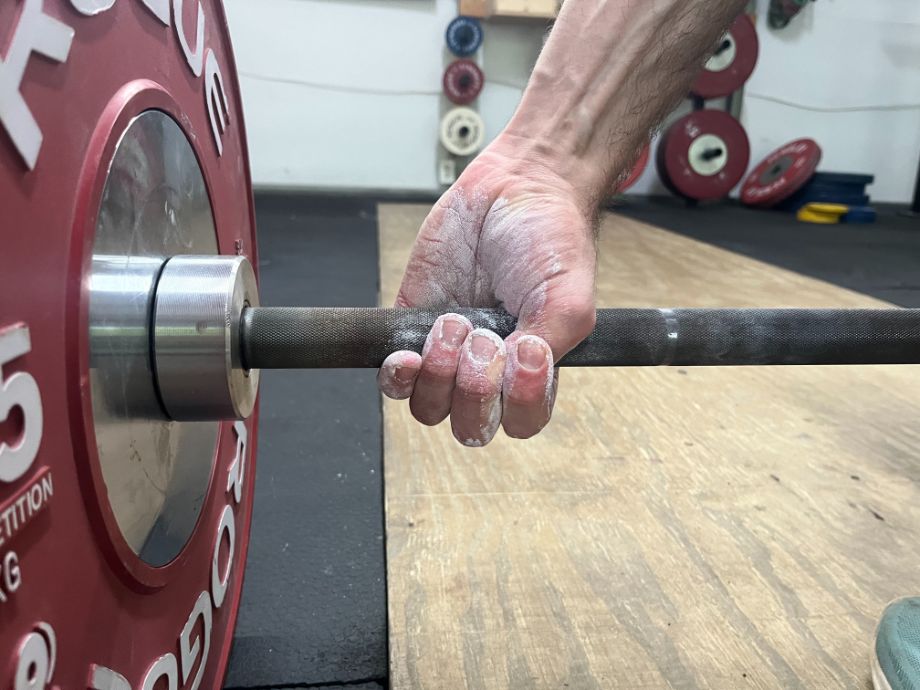
To maintain a decent grip on a barbell throughout a workout, many lifters will use gym chalk—the same oftentimes used in gymnastics. The best lifting chalk will provide good grip while keeping your hands dry. Most are simply magnesium carbonate, but some have blends of different chalks, or even essential oils.
Pulling and Jerk Blocks
Many lifters break up the lifts in training, lifting off low or high blocks instead of always from the floor. Additionally, jerk blocks are used instead of a squat rack so that weights can be dropped in between reps, instead of catching each heavy jerk back onto your shoulders.
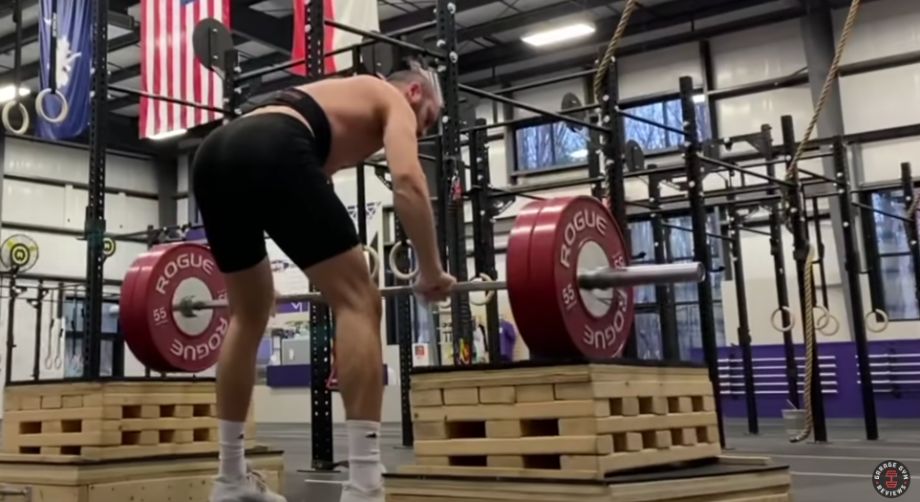
With that said, here are a few options when it comes to different blocks.
- Rogue Wood Jerk Blocks: The gym I train out of has quite a few Rogue blocks, and the great feature of these blocks is that they’re stackable. They can stack high, too; high enough that they can be used as jerk blocks instead of pulling blocks. They’re quite durable, as well, so long as you cover the block with a 2-inch topper block to absorb the impact of dropped weights.
- Uesaka Daruma Pulling Blocks: These pulling blocks are made of a dense rubber and can stack up to about knee height for most lifters. Sean Rigsby, USAW-L2, has used these blocks at his gym and mentions, “They don’t bounce everywhere when you drop weights onto them, like other rubber blocks like this tend to do.” While they’re great and durable, be prepared to spend a hefty price on these—$999. Yikes.
- DIY Blocks: If you’re looking to save a bit of money and build your own set of pulling blocks, check out our instructional article on DIY pulling blocks.
Barbell Collars
Weightlifting involves dynamic movements; you’ll need a way to make sure bumper plates stay secure throughout the entire exercise. That’s why an Olympic barbell collar is important to use for workouts.

In competitions, barbell collars weigh 2.5 kilograms each, adding a total of 5 kilograms to the bar. However, in training, you’re not restricted to those types of collars, although elite athletes train with them to simulate the feel of a competition barbell.
- Eleiko IWF Weightlifting Barbell Collars: These barbell collars are weighted at 2.5 kilograms apiece, just like the ones used in competitions. This is a great way to secure your weights during a maximal effort clean and jerk without needing to use 2.5-kilogram change plates.
- Spring Collars: The simplest way to secure weights in training is a classic spring collar. These inexpensive spring collars weigh next to nothing, so you don’t need to adjust your math on your weights, and they stay pretty secure, even on powerful dynamic movements like a clean.
- Eleiko Öppen Collars: These innovative collars have magnets and a lever-locking system to stay secure on barbells, plus a rubber interior to prevent metal-on-metal wear and tear. Ty Snipes, a USA Weightlifting Level 2 coach, uses these collars and loves them. “They are super secure and are just really nice to use,” he says. Be prepared to change up your math on weights though; these collars add a half-kilo to your loaded weights.
Crash Pads
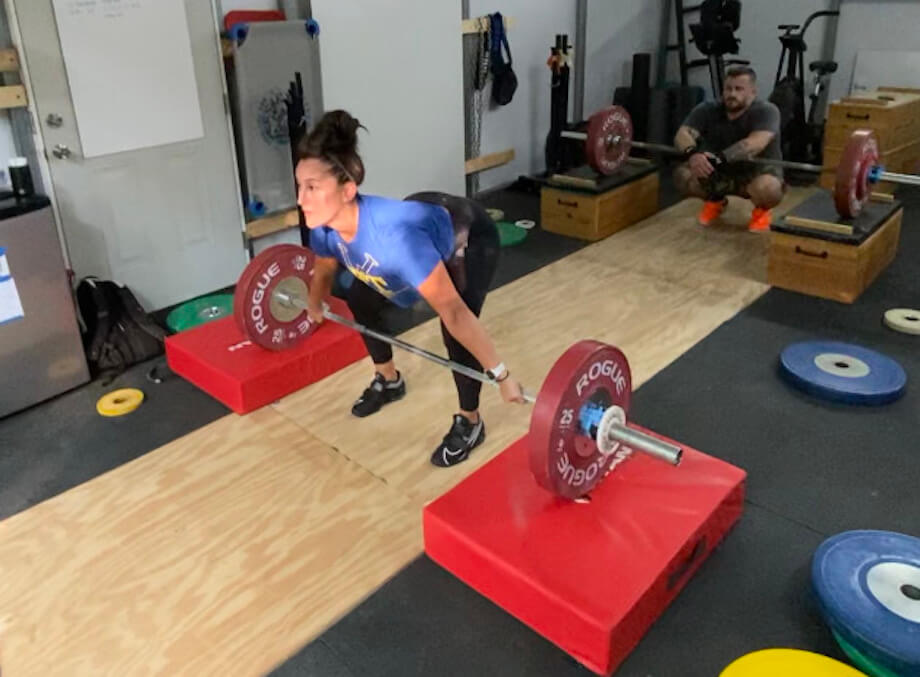
If you’re looking to keep your neighborhood happy while dropping weights time and time again, then you might need to invest in some of the best soundproof exercise mats. One unique type of mat to help with sound, and impact to your gym flooring, is crash pads. These dense foam pads can take the impact of your weights from overhead without as much banging as you’d normally hear from dropping weights.
- Titan Silencer Pads: At a 6-inch height, these silencer pads can also be used as low blocks for lifting, or even for jumps and step-ups. GGR head of content Kate Meier has these crash pads, and warns for jumps, “Just be aware your feet will sink a little, as the pads aren’t fully rigid.”
- Bells of Steel Deadlift Pads: Bells of Steel provides another pair of crash pads, which are at the same height as the Titan pads, but come in black instead of red. If you’re stuck between which pair of pads to get, I’d just go with the color you prefer, or the Titan pads are about $20 cheaper.
Dumbbells
Obviously, you won’t be needing dumbbells for dumbbell snatches (unless you do CrossFit on the side). However, accessory work is vital to a competitive weightlifter’s longevity in order to make sure connective tissue and smaller neglected muscles are strengthened. I use them routinely for my triceps, shoulders, and upper back, so when I have close to 500 pounds over my head, I’m stable.
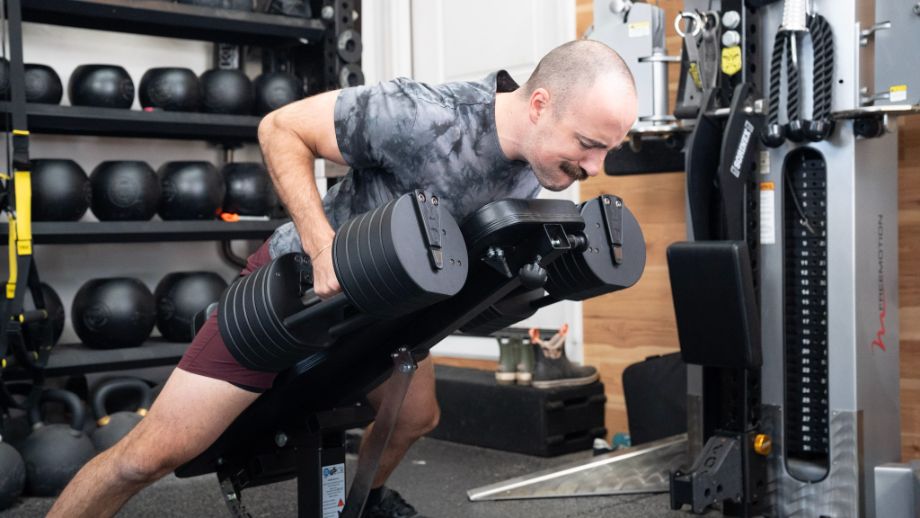
I’d recommend adjustable dumbbells to save space in your home gym, but fixed hex dumbbells work great as well.
- REP Quickdraw Adjustable Dumbbells: These recently-released dumbbells have a lifetime warranty that covers drops. Plus, they start at 5 pounds, making them great for rehab exercises. The 60-pound maximum weight might be too light for stronger athletes, though.
- Snode AD80: Snode adjustable dumbbells go up to 80 pounds, although it has a heavier starting weight at 10 pounds, and only jumps by 10-pound increments.
- PowerBlock EXP Pro 100: If you’re looking to go heavy, these PowerBlock dumbbells go from 5 to 100 pounds, and can make changes in 2.5- or 5-pound increments. These dumbbells are caged and might feel bulky if you’re used to traditional dumbbells. They’re also the priciest, as all kits would cost you over $1,000.
Weightlifting Accessories
Now you’ve got your weightlifting home gym set up and things are looking pretty sharp. You’re ready to lift some heavy weights now; or actually, you’re almost ready to lift some weights. Another thing to consider is the type of weightlifting accessories you may need in your gym. Things like shoes, belts, and wraps can all have an impact on your training regimen.
Here is a crash course into the types of accessories you could use in your Olympic weightlifting training.
Weightlifting Belts
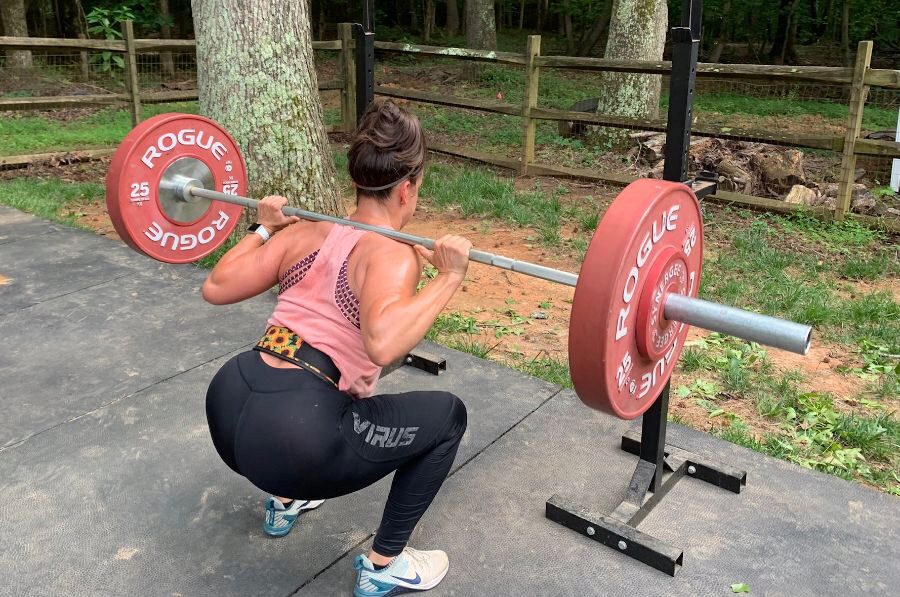
Whether you’re just beginning or squatting double-bodyweight lifts, a strong core is needed for functional movements like the Olympic lifts. That’s where a weightlifting belt can come in handy.
For Olympic weightlifting specifically, a belt can’t be wider than 12 centimeters (about 4 inches) at any point on the belt, so anything thicker won’t be allowed in competition. If you’re planning on competing, you’ll want to adhere to those standards, so here are a couple of IWF-approved options.
- 2POOD Straight Belt: 2POOD is a sponsor of USA Weightlifting with their flagship product, the Straight Belt. This 4-inch belt provides decent support while remaining flexible for the Olympic lifts. Plus, it’s available in lots of different colors and patterns.
- Eleiko Premium Weightlifting Belt: Eleiko’s weightlifting belt has a sturdy leather material with a beveled cut and a little padding on the inside for comfort. I’ve used leather belts in the latter half of my lifting career and they’ve always proved durable.
Lifting Straps

Weightlifting is just two movements, so training tends to get repetitive, and you’ll have a barbell in your hands a lot. While this is great for grip strength, it will also prove to tear calluses and wear out your grip strength over time. So to provide a little less stress on the grip and forearm, weightlifters commonly use lifting straps during high-repetition days.
The best lifting straps for lifters are typically a closed loop design, where the strap is joined together at one point and shaped like a teardrop. This allows for a quick release of a barbell, in case you need to bail out of a heavy snatch.
- Weightlifting House Lifting Straps: Weightlifting House does media and video in addition to lifting straps. These closed loop straps are designed after the Chinese team’s lifting straps, with a thick strap to wrap around the bar. They also have a neoprene padding around the wrist for added comfort during the lifts.
- Ironmind Sew Easy Straps: Ironmind lifting straps are designed for quick and easy bails, and the nylon material is some of the most durable material I’ve ever used in a lifting strap. However, the closed loop design is a bit shorter than other straps I’ve used.
Wrist Wraps
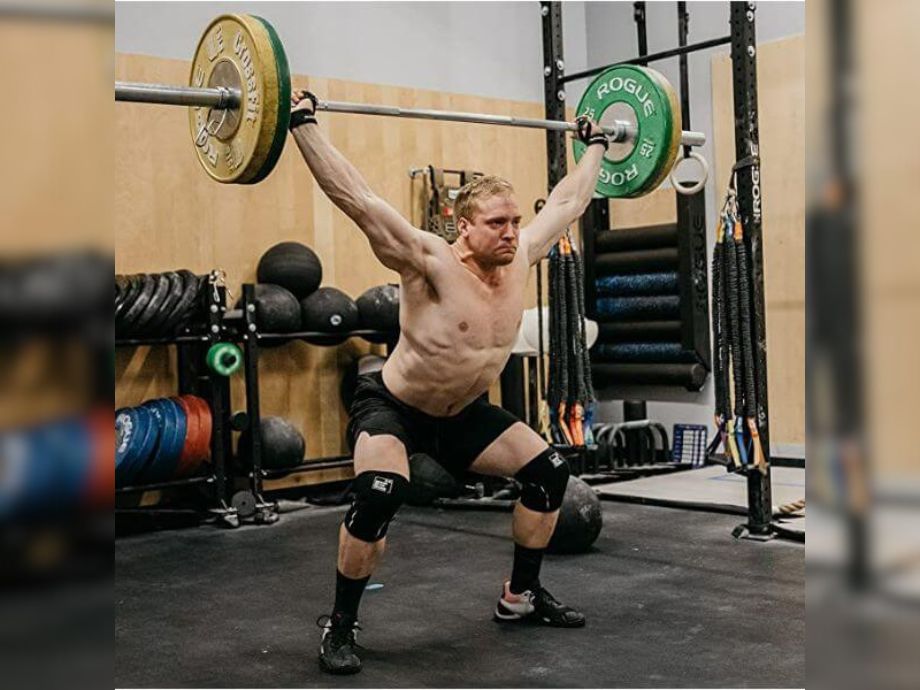
I’ll admit it: Holding hundreds of pounds of weight overhead in a snatch or jerk is not very natural. So, it’s common to want some support on the wrists during the Olympic lifts to protect the joint. Wrist wraps are a common tool to combat the strain of overhead lifting.
- Harbinger Red Line Wraps: Harbinger has long been a seller of budget-friendly accessories for strength training, and their red line wraps are great for the beginning lifter (although I used them well into my intermediate and advanced career). The elastic on these wraps provide ample compression that can be adjusted simply by how tight you want to wrap them.
- Onyx Wrist Wraps: Onyx is a company that has gained momentum and popularity in recent years, selling lifting straps and weightlifting belts, but they’re especially known for their wrist wraps. Sold as high tops, low-riders, or low tops—all describing the width of the wraps—these leather wrist wraps provide ample support for overhead movements.
Knee Sleeves
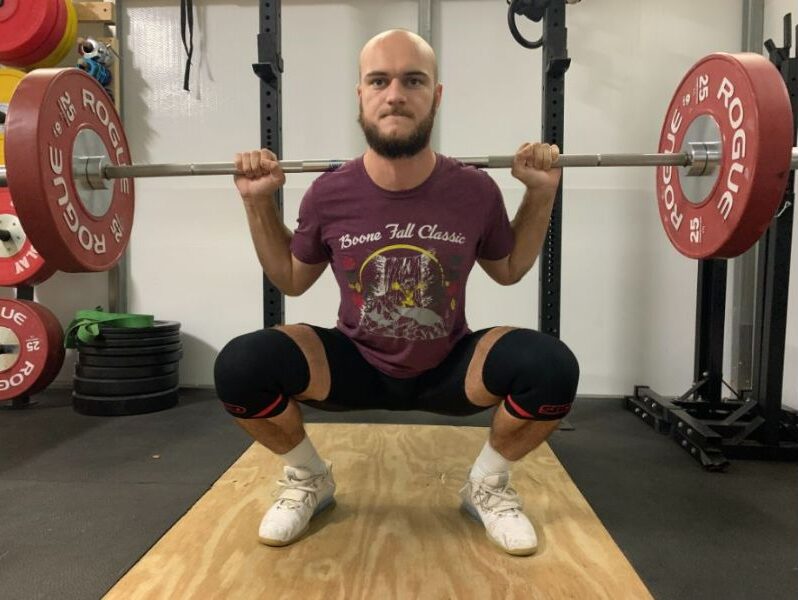
The snatch and the clean and jerk are very dynamic movements; you’ll be throwing weights around and changing direction in your squats on a dime. That’s why many weightlifters will use knee sleeves (or wraps) to keep their knees warm and compressed for maximal attempts. Designs for the best knee sleeves will vary, but here is a good sampling of popular sleeves in the weightlifting community.
- Rehband RX Neoprene Sleeves: Rehband is a favorite for classic neoprene sleeves, as the sleeve keeps knees warm and provides some compression, but not a crazy amount. They come in 3-millimeter, 5-millimeter, and 7-millimeter sizes. I myself have used neoprene sleeves for the majority of my lifting career, and the durable fabric of the Rehbands makes them some of my favorites.
- 1Kilo 2-Ply Knee Sleeves: Developed by USA Weightlifting Senior International Coach Wil Fleming, the 1Kilo 2-Ply Knee Sleeves have a greater level of support and compression over most neoprene sleeves. GGR head of content Kate Meier, CPT, USAW-L1, CF-L1, tested the sleeves, and liked their level of support, saying, “Some compression sleeves support but restrict; the 1Kilos literally help you get out of the bottom of a squat (or it feels that way).”
- Hookgrip Knee Sleeves: Starting out as a media team, Hookgrip has developed quite a few weightlifting accessories, but the most popular one has to be their knee sleeves. These don’t offer nearly as much support as other sleeves, but keep the knees warm during workouts and competitions. The thinner material also allows for better mobility of the knee joint.
Weightlifting Shoes

Just like needing a sturdy, stable platform for lifting, you’ll need a pair of shoes that also are solid and stable, so your ankles aren’t wobbling from the dynamic lifts of the snatch and clean and jerk. You’re going to need a pair of weightlifting shoes.
The best weightlifting shoes have a very stable sole. Old shoes were made with a wooden sole, while recent shoes are now made with sturdy plastic and rubber. The other main difference is that lifting shoes have a higher raised heel than most gym shoes, to help lifters remain upright in a deep overhead squat or front squat.
- Nike Romaleos 4: Nike Romaleos have been a favorite in the weightlifting community since the Romaleos 2, which I’ve used (and currently do now). The Romaleos 4 are incredibly stable, but the mesh upper doesn’t have as much support as previous iterations of the shoes.
- Adidas Adipowers 3: This is the latest iteration of Adidas’ premium line of weightlifting shoes. I’ve used the original Adipowers, and these harken back to that original design. Lifters with wide feet might want to avoid these though, as the shoes are a bit on the narrow side.
- Do-Win Weightlifting Shoes: I get it; you don’t always want to drop $200 or more on a pair of weightlifting shoes…especially if you’re a beginner trying out the sport for the first time. For those needing a budget-friendly pair of shoes, I suggest a pair of Do-Wins, which are sold for around $100.
Brands Unique to Weightlifting
Being an Olympic sport, weightlifting has had a storied history, with many brands and companies playing a role in its popularity and development. In the USA, York Barbell was a primary mover of Olympic weightlifting equipment in the 1940s through the 60s. Now, the company doesn’t make Olympic weightlifting equipment, only general fitness equipment.
The IWF approves six brands for international competition:
- Eleiko
- Uesaka
- Rogue Fitness
- ZKC
- DHS
- Werksan
Eleiko, Uesaka, and Rogue are probably pretty familiar names in the weightlifting and strength training world; however, the latter three brands aren’t nearly as well-known in the U.S. Here, I’ll go over a few unique brands to the sport that may be a little less popular or hard to find in America. But you can always be on the lookout for deals on Marketplace.
ZKC
Also known as ZhangKong, this Chinese equipment company focuses mostly on weightlifting equipment. I competed with their competition bar and plates at the Tokyo Olympics, as well as the 2023 World Championships.
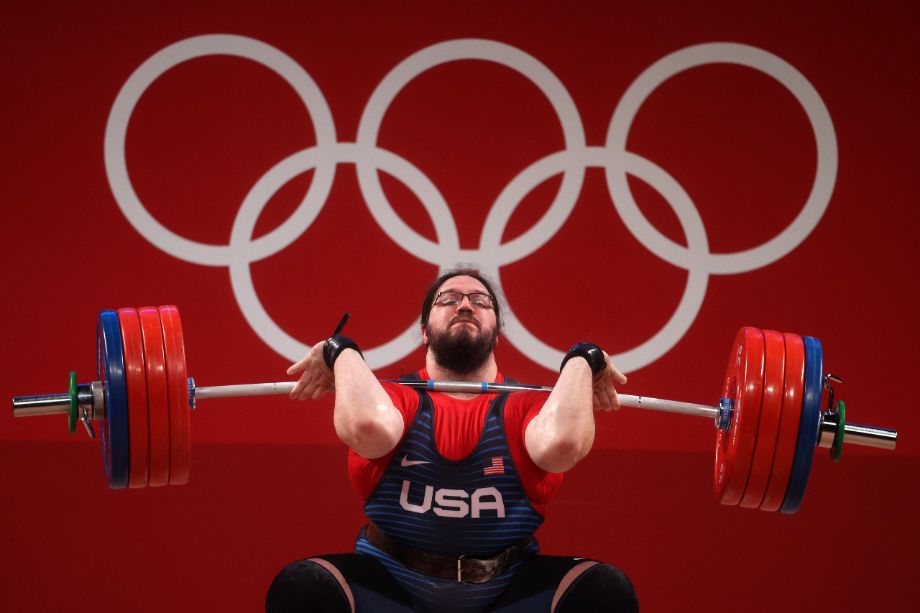
Their bumper plates are especially thin compared to other brands, making the bar oscillation feel a little off at times, although it’s barely noticeable in the heat of competition. They appear to be pushing for a U.S. presence, but don’t seem to have quite gotten there yet.
DHS
Another IWF-approved brand, DHS is also a Chinese company providing Olympic weightlifting equipment. Ty Snipes, USA Weightlifting Level 2 coach, has used their equipment before and remarks that their bars have a soft knurling and the sleeves rotate and spin very freely.
DHS had more of a presence by being sold on dynamicfitnessequipment.com; however, currently all of their weightlifting equipment is shown as sold out, and has been for awhile. Because of that, getting DHS products in the U.S. has been difficult to say the least.
Werksan
The last of the IWF-approved brands, Werksan used to have an online store for U.S. customers, and even was a sponsor for USA Weightlifting. But the U.S. store shut down just a few years ago. You can probably still find Werksan products, although they’ll most likely be used.
Ty says on Werksan barbells, “It has a very aggressive knurling—more aggressive than Eleiko. The spin on the bar is moderate, though; I’ve used some with a free spin and some with a more controlled spin.” In my experience, the plates have been very durable, too.
Ironmind
In the U.S. audience, Ironmind is mostly known for their durable nylon lifting straps, and classic lifting squat stands. However, weightlifters who have been in the sport long enough know of their media presence in Olympic weightlifting and other strength sports, and might have a poster up in their gym from them without realizing it.
Ivanko
Although not the size of Rogue or REP Fitness, Ivanko does have an online presence for American customers, although most of their products are premium products. They deal in both powerlifting and weightlifting strength equipment. Their bumper plates can be calibrated for precision, so you know exactly what weight is on the barbell.
Leoko
Old-school bumper plates were actually metal plates with a thick rubber rim on the outer edge; I used to have a pair of 15-kilogram plates in this style. While they were sturdy, they were also much louder than traditional bumper plates.
Leoko is an intriguing brand particularly when it comes to their bumper plates, as they’re still made in the classic style, of mostly metal plates with a rubber rim. They’re extremely difficult and expensive to obtain in the States, but if you can, they’ll add a nice vintage look to your home gym.
Mavrik Barbell
Mavrik Barbell has a storied past in America, with the company getting its start when founder Bob Hise II developed a weightlifting barbell that was used at the AAU Weightlifting National Championships.
The brand went out of business, but recently came back, selling incredibly durable bumper plates—with a high price tag, though. It appears they’re only selling bumper plates and apparel currently, but they’ll most likely begin to expand the Oly lifting equipment available in time.
Bulldog Sports Colombia
Bulldog Sports doesn’t have much of a presence in the United States, so getting their equipment is pretty challenging. Ty likes their bumper plates, though, as they’re very bouncy and durable, but also very thick.
Equipment for Olympic Weightlifting: FAQs
What equipment is used in Olympic weightlifting?
In competition, weightlifting equipment is pretty simple: you have a barbell and bumper plates on a sturdy platform, typically made of wood or rubber. In training, the equipment expands to squat stands for strength training as well as pulling blocks for partial lifts and accessories.
There are some special accessories lifters may use as well, such as knee sleeves, wrist wraps, a weightlifting belt, and weightlifting shoes. In competition, a lifter must wear a singlet, too.
What is a barbell?
A barbell is a piece of equipment used in strength training (powerlifting, weightlifting, bodybuilding, etc.) consisting of a long bar with weights on either side of the barbell. Typically, the barbell can accept either standard-size or Olympic weight plates. Although many barbells can look similar, they can vary greatly by their individual specs—shaft diameter, knurling, rotation system, and their tensile strength.
RELATED: How to Choose a Barbell
What lifts are included in Olympic weightlifting?
Olympic weightlifting competitions include two lifts: the snatch and the clean and jerk. In the snatch, the bar is brought from the floor to overhead in one fluid motion. The clean and jerk is broken up into two parts. First, the lifter lifts the bar from the floor to their shoulders, and then “jerks” the bar overhead before bringing it back down to the floor.

